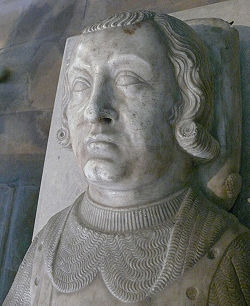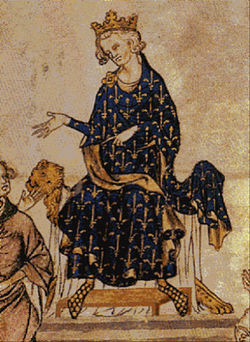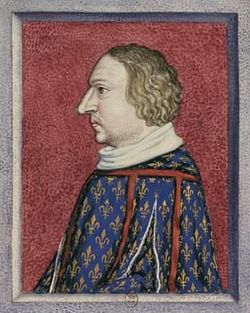Top Qs
Timeline
Chat
Perspective
Counts and dukes of Anjou
Rulers of the County (later Duchy) of Anjou From Wikipedia, the free encyclopedia
Remove ads
The Count of Anjou was the ruler of the County of Anjou, first granted by King Charles the Bald of West Francia in the 9th century to Robert the Strong. Ingelger and his son, Fulk the Red, were viscounts until Fulk assumed the title of count.
Ingelger's male line ended with Geoffrey II. Subsequent counts of Anjou were descended from Geoffrey's sister Ermengarde and Count Geoffrey II of Gâtinais. Their agnatic descendants, who included the Angevin kings of England, continued to hold the title and territory until King Philip II Augustus seized the region and annexed it to the French crown lands.
In 1360, the county was raised to a dukedom becoming known as Duke of Anjou, subsequently leading the Duchy of Anjou. The title was held by Philip V of Spain before his accession to the throne in 1700. Since then, some Spanish Legitimist claimants to the French throne also claim the title even to the present day, as does a nephew of the Orléanist pretender.
Remove ads
Counts of Anjou
Summarize
Perspective
Robertian dynasty
The Robertians, or Robertian dynasty, comprised:
House of Ingelger
Agnatic descent
Cognatic descent
House of Plantagenet
| Geoffrey V Plantagenet
1129–1151 also: count of Tours and Maine, duke of Normandy |
 |
24 August 1113
elder son of Fulk V of Anjou and Eremburga de La Flèche |
Empress Matilda
17 June 1128 three sons |
7 September 1151
Château-du-Loir aged 38 | ||||||||||||||||||||||||||||||||||||||||||||||||||||||||||||||||||||||||||||||||||||||||||||||
| Henry Curtmantle
1151–1189 also: king of England, count of Maine, duke of Normandy, Aquitaine and Gascony, lord of Ireland |
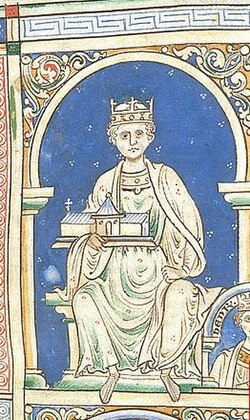 |
5 March 1133
Le Mans son of Geoffrey Plantagenet, Count of Anjou and Empress Matilda |
Eleanor of Aquitaine
18 May 1152 Poitiers eight children |
6 July 1189
Chinon aged 56 | ||||||||||||||||||||||||||||||||||||||||||||||||||||||||||||||||||||||||||||||||||||||||||||||
| Henry II named his son, Henry the Young King (1155–1183), as co-ruler with him but this was a Norman custom of designating an heir, and the younger Henry did not outlive his father and rule in his own right, so he is not counted as a count on lists of counts. | ||||||||||||||||||||||||||||||||||||||||||||||||||||||||||||||||||||||||||||||||||||||||||||||||||
| Richard Lionheart
1189–1199 also: king of England, count of Maine and Nantes, duke of Normandy, Aquitaine and Gascony, lord of Ireland |
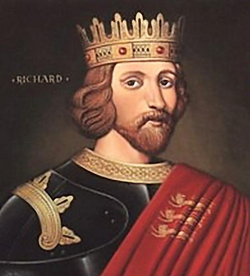 |
8 September 1157
Beaumont Palace son of King Henry II of England and Eleanor of Aquitaine |
Berengaria of Navarre
12 May 1191 Limassol No legitimate issue |
6 April 1199
Châlus aged 42 | ||||||||||||||||||||||||||||||||||||||||||||||||||||||||||||||||||||||||||||||||||||||||||||||
| Arthur
1199–1203 also: duke of Brittany |
 |
29 March 1187
son of Geoffrey II, Duke of Brittany and Constance of Penthièvre |
never married
no issue |
April 1203
Rouen aged 16 | ||||||||||||||||||||||||||||||||||||||||||||||||||||||||||||||||||||||||||||||||||||||||||||||
In 1204, Anjou was lost to king Philip II of France. It was re-granted as an appanage for Louis VIII's son John, who died in 1232 at the age of thirteen, and then to Louis's youngest son, Charles, later the first Angevin king of Sicily.
Capetian dynasty
House of Anjou
In 1290, Margaret married Charles of Valois, the younger brother of king Philip IV of France. He became Count of Anjou in her right.
House of Valois
In 1328, Philip of Valois ascended the French throne and became King Philip VI. At this time, the counties of Anjou, Maine, and Valois returned to the royal domain. On 26 April 1332, Philip granted the county to his eldest son, John:
Following John's ascension to the throne as John II in 1350, the title again returned to the royal domain.
Remove ads
Dukes of Anjou
Summarize
Perspective
The dukes contributed greatly to social reform in the 1300s and 1400s.[1]
First creation: 1360–1481 – House of Valois-Anjou
On the death of Charles IV, Anjou returned to the royal domain.
Second creation: 1515–1531 – House of Savoy
Third creation: 1566–1576 – House of Valois-Angoulême
Fourth creation: 1576–1584 – House of Valois-Angoulême
Fifth creation: 1608–1626 – House of Bourbon
Sixth creation: 1640–1660 – House of Orléans
Seventh creation: 1668–1671 – House of Bourbon
8th creation: 1672 – House of Bourbon
9th creation: 1683–1700 – House of Bourbon
10th creation: 1710–1715 – House of Bourbon
11th creation: 1730–1733 – House of Bourbon
12th creation: 1755–1795 – House of Bourbon
Remove ads
Dukes of Anjou without legal creation
Summarize
Perspective
1883–present – House of Bourbon
After the death of Henri, Count of Chambord, only the descendants of Philip V of Spain remained of the male line of Louis XIV. The most senior of these, the Carlist claimant to the Spanish throne, became the eldest of the Capetians. Some of them used the courtesy title of Duke of Anjou, as shown below:
At the death of Alfonso Carlos in 1936, the Capetian seniority passed to the exiled King of Spain, Alfonso XIII. In 1941, Infante Jaime, Duke of Segovia, succeeded his father Alfonso XIII (Alphonse I of France according to the Legitimists) as the heir male of Louis XIV and therefore as the Legitimist claimant to the French throne. He then adopted the title of Duke of Anjou.
2004–present – House of Bourbon-Orléans
On 8 December 2004, Henry, Count of Paris, Duke of France, Orléanist Pretender to the French throne, granted the title Duke of Anjou to his nephew, Charles-Philippe d'Orléans. Since he did not recognize his cousin's courtesy title, in his view, the title was available since 1795.
Remove ads
References
External links
Wikiwand - on
Seamless Wikipedia browsing. On steroids.
Remove ads











